When I awoke this morning, I knew it was Thursday. I also left my head on the pillow (and my right hand on Buster the cat, who loves to snuggle in the morning) while I mentally flipped through blog concepts for today. It was another one of those “I have no idea” Thursday mornings. I was drawing a blank.
After I got up and prepared to face the day, I headed down to my office in the lower level and fired up the laptop. My first stop was my Google Chrome account, which I only use for book writing because it allows me to share my chapters with editor Greg Halling, who can then make changes or suggestions and send it back to me. I was happy to see something new in the In-Box, from Greg. He’d just finished editing Chapter 15, and his only comments were “This stuff just flows, man. You’re writing at a consistently high level.” Now if that doesn’t fire you up for putting fingers to the keys, nothing will.
For this book, I’m utilizing all sorts of different approaches and different strategies than I utilized for “Bats, Balls, & Burnouts.” When you’re writing your life story, you can pretty much just sit down and write every day. It’s all in there. It’s all my voice.
But for “How Far?” it’s all different. I need to channel the two characters in order to write in their voices, and some days they just don’t cooperate. Writing isn’t like weight lifting. You can’t just “try harder” on days you don’t feel it. So I write at whatever pace my brain tells me to use. If it’s not coming effortlessly, I’ll get up and do something else. Go for a walk. Have a bowl of Cheerios. Go lift some weights, where you can try harder to do it.
Within a few minutes after reading Greg’s comments, and looking at the subtle changes he had made in that chapter, I started to realize what today’s blog would be about. I am, I believe, writing at a new level now. And, it continues to evolve and transition. No matter how long I’ve been doing this, there are new territories to conquer and tools to use. But, so many of the tools I use every day come from influential writers and their books. How did those works impact me so much that the styles or approaches stayed with me? How did I adapt those tools to my own set of skills?
I started thinking back over many of my favorite books, which led to thinking about the most influential books I ever read. Books that didn’t exactly show me how to do it, but showed me what could be done, and showed me new approaches I could either absorb or ignore. That’s today’s subject. Not necessarily my list of all-time favorite books, although all of these would be in those rankings, but rather the most influential and important books I’ve absorbed. And, I’ll tell a few of the reasons why they hold such a place for me. These are in no particular order.
Back in the mid-80s I started to hear a lot of people talking about the book “Communion” in reverential tones. It was written by Whitley Strieber. The most common comments were “You have to read this book. You won’t believe it.” So I went out and bought it, because you had to do that back then. No Kindle versions or Amazon to help you. You had to go to a bookstore. And I did.
“Communion” was incredible, and not just in a stylistic sense. To this day, Mr. Strieber insists that it’s all true and it happened to him and his family. What happened? They had “visitors” and their lives were changed. It was about alien abductions and recurring visits. It was mind blowing. And it was not a happy story. No Alf or ET among the visitors.
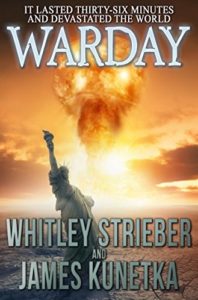
I only tell that story because it was the way I was introduced to Whitley Strieber’s work. A few years later, while browsing in another bookstore, I saw he had a new book out, and he had co-written it with another author, James Kunetka.
I bought it and dove in. It’s a dark book, there’s no getting around that. It’s horrifying, and scary, and so well crafted it feels like a memoir instead of fiction. It’s about all 36 minutes of World War III and the aftermath. It’s a book you hope will never come true.
But what stayed with me after reading it was the style. Strieber and Kunetka alternated chapters, writing as two characters who knew each other, but who each had their personal views and their own way of telling what it was like after the bombs went off. It mesmerized me. I, obviously, never forgot the technique.
When it was time to write a new book, I was initially stumped as to the theme. I knew I wanted to tackle fiction, but wasn’t sure how I was going to do that. And then I remembered “WARDAY” and the way it was put together. I remember telling Barbara, “There was this book, by Whitley Strieber and another author. Remember “Communion” from the 80s? Everybody was reading that book, and Strieber wrote it. For the book ‘WARDAY’ he and the other author alternated chapters, telling the same story from two different perspectives. Maybe I can find someone to do that with me.”
I thought about it for a day or two, trying analyze who I could wrangle into doing this project with me. What would be the challenges? What are the potential pitfalls? You certainly don’t want to ruin a good friendship if it all goes wrong! A few days later, over dinner, I told her, “I can do this myself. I can write it as two different characters, in their own voices. It will be a challenge, but I know I can do this.”
And so Whitley Strieber made his mark in my head. I never forgot the concept.
This next one is an absolutely mammoth book. At around 675 pages, it was also published in a small font with narrow margins and thin paper. It took weeks to read it. It was pure brilliance, but it was so complex and full of details it spawned a movie that couldn’t come close to capturing it all. You can’t take 675 pages and turn it into a 2-hour film, no matter how many major movie stars are cast. Robert Redford has basically one scene. The movie was really confusing and had no flow. The book was a masterpiece.
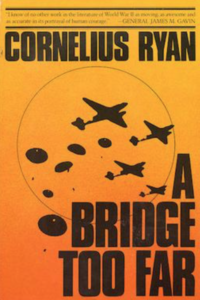
Cornelius Ryan was likely the greatest author in the “war history” genre. And his technique was exhausting, to him and to most readers. He spent years researching, interviewing, and digging for his favorite thing. Details!
He then crafted his books to tell the stories from an insider’s view, and the reader feels they are there, in the gliders crash landing, on the bridges, in the rivers, under assault with bullets whizzing over their head, and in the war room around the strategy tables.
The book “A Bridge Too Far” was also groundbreaking in another way. It was a microscopically detailed account of a battle that was really a loss and a legitimate setback for the allies in World War II. Up to this point in publishing, the vast majority of books about particular battles came from writers on the side of the victors. As much as the American and British allies wanted to spin it that the Operation Market Garden offensive was “mostly a win” there was no such thing. That was propaganda. It either was a complete win, or it was a horrible loss. There is no “kinda sorta” when it comes to war. In their race to take a series of Dutch bridges from the Germans, they overextended themselves. They tried to go a bridge too far. Had they stopped after taking the bridge in Nijmegen, just 16 kilometers south of Arnhem on the Waal River, the operation would have been an unqualified success.
When I read the book, I totally got Ryan’s style. Details, details, details. The beauty of it is in the details. The book impacted me so much. In the early 90s, I was on a trip in Europe and I made an important detour through the Netherlands in a rental car. I had to see the Arnhem bridge. It’s still there, and it still wears the scars of the deadly battle.
This next book is not about the fictional World War III nor the factual World War II. It’s about baseball, and is roundly considered the best baseball book, if not the best sports book, ever written by an athlete. I’ve read it dozens of times, as have many of my friends. It’s “Ball Four” written by Jim Bouton, a very real baseball player and a very talented writer.
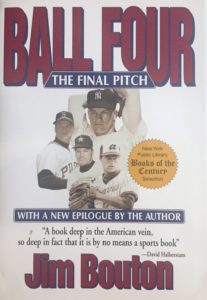
Up until Bouton spent the 1969 season taking copious notes and writing pages of stories while he pitched for the mostly forgotten Seattle Pilots in the American League, baseball books were almost always ghost-written and white washed. Ballplayers could tell a writer some stories, but they didn’t generally have the writing chops to do it themselves. And beyond any doubt, you didn’t tell stories that might upset anyone in even the slightest way. It was all rainbows and unicorns, for decades.
And then the former Yankees pitcher wrote his book. Originally a hard throwing fastball guy, Bouton hurt his arm and mounted a long and painful comeback through the minors, learning the art of throwing a knuckleball because it didn’t make his elbow feel like it was going to explode. When the Pilots were formed, he earned a spot on the roster. And he kept a lot of notes. He was out in the open about it, his teammates knew what he was doing, but they didn’t know how he’d write it.
He spared no one. If he admired and loved you, it came across in the book. If you were a jerk, he told those stories. Carousing too much? Yep, even when he was involved. Were team management and Major League Baseball always right and always fair. Of course not. If a coach or teammate treated you with disdain because they thought you were an “anti-establishment weirdo” (remember the era) would you just gloss over that? Why would you? Even his memories of his days with the Yankees were eye-opening. Before Bouton, you just didn’t write the truth, the whole truth, and nothing but the truth about Mickey, Whitey, and the Yanks. Bouton did.
And by the next year, after the book was out and being badmouthed by players and coaches far and wide (most of whom would also admit they hadn’t read it) Bouton was blackballed and out of baseball. But the book… The book lived on with many additional editions as his life changed and he finally made it back to the show as a knuckleballer for the Atlanta Braves. Why the Braves? Because owner Ted Turner loved those who were willing to be renegades. He was one himself.
I hold “Ball Four” in a very high and special place. It made me wonder if I could be an athlete who could also write. Bouton’s masterpiece is still hilarious and poignant, and basically it’s just a great book. But to me, it was an inspiration.
And those Seattle Pilots? After one season they were bankrupt and caught up in litigation. The players actually reported to spring training, wearing Pilots uniforms, but they didn’t know where they would end up or if the team would fold. During camp, just weeks before the season opener, a deal was sealed and Bud Selig bought the organization, moving the Pilots to Milwaukee where they became the Brewers. But for one year, the Pilots and Bouton left their mark. He certainly left a mark on me.
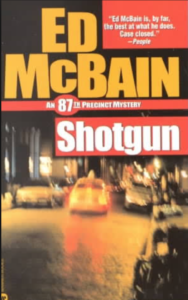
This next one influenced me well before I ever thought I’d do something as audacious as writing a book. I went through a detective/crime drama phase in my 20s, reading great classic writers like Agatha Christie and Dashiell Hammett, while also enjoying the pros of the day, writers like Sue Grafton and her “alphabet series” of crime novels. And then I discovered Ed McBain.
He wrote a number of different series of books, and this group was the 87th Precinct string of novels and characters. By the first 10 pages of my first McBain book, I was struck by his mastery of conversation. His technique eschewed many of the strict rules of writing when it came to characters talking to each other. That typically tends to get pretty choppy and stilted, with a lot of “he said” or “she responded” attributions.
When McBain had his characters speak, it was as if you were in the room with them. It was free-flowing and fluid, and it sounded like real people. At the time, I was too young to really consider what made it special, but I knew his style was something I really loved. When it was time to write “Bats, Balls, & Burnouts” my McBain memory was reignited. When I started “How Far?” and I had to write in character, in specific voices, all those things I absorbed from his writing came back to the front of my mind. I’ll never be anything close to Ed McBain, but his impact stayed with me forever, after I read my first 87th Precinct book.
And by the way, Ed McBain is a pseudonym. His name by birth was Salvatore Lombino, but he legally changed it to Evan Hunter when he was 26 years old. He wrote under the pen names of John Abbot, Curt Cannon, Ezra Hannon, and Richard Marsten, but Ed McBain was the pen name that made him famous.
And finally, the funniest writer whoever made me laugh out loud while flipping the pages of his nearly endless string of hilarious books.
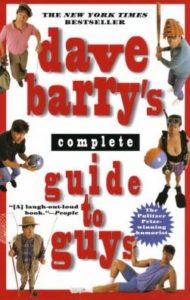
Dave Barry has been a humor writer for a long time, and was a columnist for the Miami Herald. His columns spawned his books.
Comedy is like a salad bar. What looks appetizing to me, and makes me happy, may draw frowns and a “yuck” from the next person in line, who themselves are constructing something I can’t even stand to look at. Dave Barry is my perfect salad bar.
After I read his first book, I could see the impression he made upon me the next time I wrote anything. When I began my blog, in 2005 on NHRA.com, I could sense my own version of “Barryisms” creeping into the copy. I actually talked to editor Phil Burgess about that, because I wasn’t sure if I should defile Mr. Barry’s style by imitating it a little. As it turned out, Phil was a huge fan as well, and as he said, “Sometimes imitation is pure flattery, but don’t try to be him. Be you, but if you can be funny like he is, go for it.”
I have no idea if I ever succeeded in that regard, but Dave Barry still resides in my brain, and I see his impact often as I write. Whenever you see me write something along the lines of “So I got in line and it moved fast (if by “fast” you mean not at all).” that’s me channeling Dave Barry. He’s a riot, but he’s an artist with his words. He made a huge impression on me, and he still does. The guy is a comic genius. I’m a rank amateur.
So there you have it. Five books and authors that not only gave me great pleasure, but which also influenced me to the point of having something to do with what I am as a writer today. I can’t be any of these gifted authors, but I can be me and I can salute them by having learned something from each of them. There’s a little bit of each of these people in me today. I’m thankful for that.
That’s probably enough for this week. It was kind of a “wonky” blog today. A bit of “inside writing” stuff, but I enjoyed even thinking about what all these books and authors have meant to me. There are many more, but the first five that came to mind were the five that made the cut.
If you enjoyed any of this, I have but one standard weekly request. Please click on the “Like” button at the top. It’s easy. Almost painless.
See you next week. I have no idea what I’ll be writing about.
Bob Wilber, at your service and still wondering how many other voices I hear in my head.